This is the transcript of a talk given by Paul Jennings to the recent SBUK Big Straw Bale Gathering. Paul has built his straw-bale family home on a ‘One-Planet Development’ smallholding in Wales (costing £12,000).
Introduction
My partner and I built our first straw bale house in 2000, a very low spec Nebraska-style cabin on shipping pallets, with reclaimed windows, vigas cut on the site for a single pitch roof. It was 20m long and 6m wide, like a straw bale railway carriage; reclaimed forklift truck floor and earth rendered walls. We built it without planning permission, on the farm rented by the co-op we were members of, became something of a local cause celebre, and when we left, the building transitioned through accommodation for another couple, to an artist’s studio, and was finally disassembled, recycled and composted. £4000 build.
We’ve done quite a lot of funky self-building since, and we’re living in another straw bale cabin now on an OPD project in Carmarthenshire. £12,000 build. I’m not going to talk about straw bale building though, at least not directly. I’m going to talk about issues related to it, and how I think Permaculture design might be relevant to straw bale builders.
*
Asked why Permaculture emerged in Tasmania, David Holmgren said that it’s a place where nature and modernity collide, both creatively and destructively. It was a place where the ferment of the 1960s, the rising awareness, after the publication of the Limits to Growth, of the strain being placed on the Earth system, and on-the-ground resistance to environmental destruction, coalesced into a rising environmental consciousness.
Holmgren says of Bill Mollison, Permaculture’s perhaps more famous originator, that his “life and ideas epitomised a creative bridge between nature and civilisation and between tradition and modernity.”
Mollison hoped that Permaculture would provide a positive way forward, an alternative to the global society, militaristic, exploitative, polluting, and insensitive to human needs.
Between 1972 and 1974, Holmgren and Mollison worked out the shape of Permaculture as an interdisciplinary earth science with a potential for positivistic, integrated and global outreach.
Permaculture draws on influences as diverse as Eugene Odum’s work in ecology, Taoism and Buddhism, traditional tribal wisdom, Kropotkin’s anarchism, organic farming, and the work of the architect Christopher Alexander.
The word Permaculture comes from the portmanteau combination of permanent and agriculture, but very quickly practitioners and designers came to see that permanent culture must underlie all concern for the soil and the production of food.
Permaculture came with Mollison, out of the forests, with a new paradigm for feeding the world, one which remains desperately relevant today, but Permaculture is not just clever gardening, it is much more than that.

Credit: Paul Jennings
It’s perfectly possible to grow organic food with all attention to good soil care, and to plant health, indeed to a thriving agroecological system, but as part of an entirely unsustainable culture. Indeed, you can walk into a supermarket and buy organic food grown on illegally occupied land, or grown with stolen water, or with very little regard to human rights. The same is true of any aspect of modern living to which we would like to append the label sustainable.
It’s great when people cycle or take public transport, it improves air quality and reduces carbon emissions, but a cycling stockbroker can do much more damage to the Earth in a day at work than he will undo in a lifetime of donning a high-vis and weaving in an out of traffic on his bike.
Permaculture design is holistic, it emphasises relationships between elements in systems. It’s not about beating ourselves up because we’re not perfect, but it is about putting this work which we must undertake into some perspective. In one sense, Permaculture invites us to recognise that we face a multi-generational task of reconstruction and change.
Those of us in this room, even under ideal circumstances, will not see the realisation of the ecological society which both humans and the Earth require. In another sense though, Permaculture is an urgent demand. It was conceived as a response to crisis, and in the half century since The Club of Rome said that business as usual could not continue, that crisis has only deepened.
As a Permaculture designer, I could help you design a grey water system for your house, or to place a productive kitchen garden on your site, but Permaculture is better understood as a guide to whole site design, to settlement design, and indeed to region design. We might start with where we put the duck house, but if we’re not thinking about how our region might produce appropriate building materials, or how we might all farm in a way which maintains and improves the health of our shared river systems, we’re not practising Permaculture.
Just as a language is made up of words which on their own mean little or nothing, but which can, when placed together, make meaningful phrases, so individual examples of potentially sustainable design or technology, on their own are just disconnected patterns, but they can be combined to form a recognisable Permaculture pattern.
We are educated to look at solar panels and see something sustainable; we may see an electric car, or the organic symbol on a milk bottle; a wind power generator on the horizon, or homes being built with bales, and associate these things with a sustainable future. Permaculture suggests, to me at least, that these are all lower order patterns which on their own make little sense; they are fragments, as half words in a young child’s progress towards language. It’s really instructive that Christopher Alexander’s Pattern Language for architecture doesn’t start with roofs or walls, it starts with independent regions.
Temperate Permaculture and buildings
Having said all of that, of course Permaculture does have things to say about individual buildings. We start with the patterns and we work to the details, the details are interesting and vital, but on their own they make no sense.
In Temperate Permaculture, Mollison said, 50% of the work is about buildings. Traditional patterns of settlement and building design reflect just this need to cope with the weather.
We can usefully list the functions of our buildings, working in our designs towards the Permaculture principles of every element having multiple function, and every important function being supported by multiple elements.
- Housing for people
- Shelter for domestic animals
- Storage of food
- Storage for tools and equipment/implements and vehicles
- Workshops, more or less specialised
- Transformation of food – the bakehouse with oven, the dairy, the brewhouse etc.
- Microclimate – buildings as windbreaks, suntraps, covered areas, shaded areas etc etc
- Security for people and the things we value
- Growing areas – propagation, plant support
- Wildlife habitat
- Social events – a huge list on its own
- Beauty, creativity and expression
- Rainwater harvesting
- Education
- Play
- Businesses
There are surely more, and we could discuss definitions, but the point is that our buildings can work very hard, much harder than the standard image of say the contemporary suburban house, abandoned in the morning only to come back to life when the kids get home from school, a dormitory in effect, with an inconvenient garden to maintain, no economy of its own, and a demographically bizarre subset of residents, no old people, no young people.
Buildings through the lens of Permaculture
I’d like you all for a moment to imagine that you are beavers. In fact, if we could all just undertake to go home and to live in the landscape in the spirit in which beavers do, I could stop this talk right away.
Beavers of course build in a traditional style, using locally available materials and techniques accessible to all beavers with a reasonable education. Their homes are integral to the production of their food, and the way they manage the landscape creates long term benefits for a very wide range of other species, including homo sapiens. Even when beavers leave a home the beaver meadows they leave behind remain a permanent resource for other lifeforms.
Beavers of course have huge advantages over us: they don’t have several thousand years of hierarchical social development behind them, and they don’t seem prone to overthinking. Permaculture design might be seen as one way in which we can begin to emulate beavers; as emulators we may never be as useful as beavers are in terms of ecosystem stewardship, but we can try. We can take an ethical approach and we can use good design principles.
*
Ethics and principles are the building blocks of Permaculture design. They can be seen as a checklist, but also as a series of functions with which we want to support each other in our buildings, on our sites, in settlements and in regions as a whole.
Often taught as three ethics: earth care, people care and fair shares, really, because they are inextricably bound together, it is best from the start to see one Permaculture ethic. Unequal societies destroy their land base; societies which do not look after people create inequality; the destruction of the land base affects people disproportionately according to their wealth and power. In other words, there is no way to separate caring for the earth from caring for people or caring for people from caring for the Earth. I appreciate that this could give rise to a very long discussion. It’s enough at this stage, to understand that this is an intrinsic characteristic of Permaculture.
What might buildings and settlements look like through the lens of Permaculture design? My own take on this question goes something like this: buildings should be constructed using accessible technology, easily learned, as safe as possible, readily adopted by people of different abilities and ages. Buildings should be non-toxic (bearing in mind the need for dust masks even on ecological building sites!) both in construction and in habitation – something we consider safe when built might well be dangerous to later adaptors or indeed demolishers of our buildings; they should be both durable and then adaptable, in the final analysis, probably compostable. There should be potential in our buildings for site self-reliance, in food, in water, in energy; our buildings should be beautiful, not in the opinion of Prince Charles necessarily, but in the opinions of all of the creative people who build them and use them; they should be customisable, and have the capacity to evolve through long centuries; buildings must be affordable, supporting equality and providing material security for young and old; buildings then should support the vision of the society we want, and they should make sense in the landscape, oriented in every sense to fit. Built from local materials in old or new bioregionally sensitive vernaculars, our buildings should not only not push at planetary boundaries, they should actively help to repair the planetary boundaries we have crossed.
Quite a manifesto, but in itself probably containing little that is unfamiliar to this audience. What may be more interesting then, is how Permaculture design might help us towards these goals.

Credit: Paul Jennings
Whole site design
All of us as self-builders tend to focus very much on the building. We need to move into it, to stop paying rent, or to stop living in a caravan; we need to get the budget for the build under control, or the budget is already blown.
One reason that a transitional building, or an evolving building can be an advantage is that it can allow us to create a design which will better integrate buildings and site, or land use, rather than segregating them. The idea of a building built once, finished and then moved into, is a relatively modern one; and one which arguably doesn’t sit all that well with naturally changing human needs.
What we look for when we start whole site design, including integrating buildings, is beneficial relationships between elements, or parts if you like, of our plan. In Permaculture design we talk about good relative location. In fact, if you take it as read that you will try to understand the functions of the elements which you are designing for, then much of good design for ecological functioning is about relative location.
In Permaculture design we start with the slope of sites which influences the flow of water, of nutrients, of cold air, of work and life, and links to well-designed access and how to lay out paths and tracks.
We consider aspect and the way it influences solar gain, shade, where we want light for buildings or plantings, the weather we are exposed to, which links also to the Permaculture design tool – sector. Sector surveying and design is about the energies coming on to our site, and flowing through it. This is analogous to the flow of energy into an ecosystem. When mapping sites using sector, and following careful and prolonged observation, we record prevailing winds, cold winter winds, water flows, floods, wildfire risks, the flow of wildlife, of people and vehicles, of light and shade, and potentially a whole host of other energies. If we conceive of our site in the abstract as a circle, then energies coming on to the site are mapped as sectors or segments.

Credit: Paul Jennings
In terms of design outcomes, the proper application of these tools will always save energy, should save money, and may save lives.
There are many other factors taken into account during what Geoff Lawton calls mainframe design, not least soil and site biodiversity; of course the resources and the desires of the people involved; and the legal and wider social context of the development.
What we expect to see in new developments arising from this process is mid-slope placement, below wooded steeper slopes and above the floodplain; often houses at the keypoint where the convex slope of classic s-shaped landscapes meets the concave lower slope, work which recognises the varying soil qualities of slopes and lowlands; reduced exposure to winds and weather; landscaping and planting which slows water flow and radically reduces risk of dangerous flooding and erosion.
Many Permaculture strategies make use of modern techniques combined with the oldest patterns of land use and settlement. If you get the chance on your way home, see how many mid-slope farms you see, pay attention to where old settlements occur in the landscape; think about how a farm which runs from a ridge down to a river traditionally made use of its land.
Permaculture principles and buildings
Site design improves building function. Working from patterns of landscape design and land use, we work to details, like how our buildings fit into the landscape. From pattern to details is a technique of nesting one pattern or design in another, a higher order system. For example: a bioregional pattern to localities; localities to site developments; site landscape developments to buildings, gardens or orchards; house to conservatory; conservatory to watering system or composting process; watering system to plant species choice or gardening practice.

Credit: Paul Jennings
Hopefully then, you’ll see that design of good buildings, the sort which we might readily call “ecological”, cannot really begin with just building design. By definition the ecological must be linked in a complex web of relationships to both higher and lower order systems. If ecology is your thing (and it should be your thing) then the short phrase which is your house makes no sense unless combined in a sentence which refers both to landscape and how you deal with your bodily wastes, or what you use to clean your worktops, or how much of your own food you grow.
So let’s place our buildings in an understood and designed landscape where windbreaks reduce our energy needs, and where zonal design reduces work and helps us to create self-sustaining abundant household and settlement economies of the sort we are going to need.
Let’s ask ourselves what a building can do. We can go back to the list of functions and examine our plans or our existing structures, and we can make our buildings do more. When we do this, investing in buildings, we make them more energy efficient, we reduce long-term costs and work,and we create a human environment which meets more of our needs whilst using less of the Earth’s resources, increasing our security and improving the prospects for future generations.
A well known Permaculture principle is multiple function. Instead of planting a fruit tree and asking of it only fruit, we plant it for shade and microclimate creation, we use it as part of a plant guild with soft fruit bushes, deep rooted mulch plants, insectary plants and nitrogen fixers; we put a bird box on it, and as well as taking fruit for our table, we run chickens underneath to peck at windfalls and control pests, turning them into eggs. When we cut the tree back to let more light into the garden, we chip the wood or compost it, cycling nutrients like a forest.
We can stack functions in space like this, for buildings. We do anyway, but we can design to do it better. A house can be a home for people, and for bats; a room can be a place to eat and a place to hold meetings; a place where, as we plot the downfall of capitalism we can draw books from well placed shelves. A house can be a place for education of children; a place where we care for all generations; a place which produces food, and which deals with its own wastes by using them to meet the needs of other elements in the design, a design aimed at abundance.

Credit: Paul Jennings
Stacking functions in space, thinking of a house in the same way we think of a forest or a forest garden, can work with stacking in time. The building we’re living in now might become something else as needs and desires change. So, a well designed barn might come to provide accommodation, it might become a shop or a monthly produce market; a seasonal store; a place for courses or Solstice feasts. Over time, a well designed building may go through transformations, and we can design for that. There are very good historical precedents, it’s how buildings were once nearly all used.
Applying good design for relative location to our buildings, vis-a-vis other buildings and elements in our designs, can give rise to very efficient single envelope constructions, to evolving courtyards; to the kinds of places which feel bigger than they really are because they are thoroughly inhabited, full of all kinds of human activity.
We can build in backup plans, accommodation for young and old; spare capacity for storage. We can take seriously David Holmgren’s call to catch and store energy, not just in solar panels, but as food in larders, as water; as knowledge for dissemination; as growing community. Thinking about buildings like this is Permaculture thinking, because a house as just a place to sleep and watch television is a place segregated from the other functions of human life, from the meeting of a whole host of human and ecological needs.
Integration brings buildings back to life. As a side benefit it reduces food miles; reduces hours behind the steering wheel; it brings generations back together. Well-designed buildings in a well-designed landscape provide the matrix for a very different kind of society from the one we have now.
Buildings in a rapidly changing world
Finally then, it’s to the future which the society we have now is taking us that we must turn. All ambitious and perhaps utopian thinking aside, we face an urgent need for Permaculture design in our buildings, new and old, and in our settlements.
The future is pretty scary. We know that large commercial builders don’t take the future seriously,not beyond the next dividend payment anyway, and of course we are all aware that the government is in no way prepared for the likely scenarios we face by the middle of this century. It seems to me that the government is unprepared for next year, let alone 2°C of global warming. To the extent that we can, we need to take our very survival in our own hands as we design the places we live, our livelihoods, and as we think about how we might cope with living in dramatically changed times.
This is the Apocalypse slot. I apologise.
We are going to experience much more extreme weather. We need to design and build for more high winds, probably extremely high winds. Preparing for this will involve thinking about some of the things I have already mentioned: building and settlement placement; planting properly designed windbreaks. It will also demand earthworks. We will need to think about earth sheltering, possibly even taking Mike Oehler’s route and going underground; we will need to familiarise ourselves with hurricane proofing: combinations of earthworking, planting and building using traditional typhoon proofing approaches from the Pacific Islands. Does anyone know what wind speed will peel their roof off? I don’t believe the roof that I live under will be enough for the future we likely face, not without more work on its structure, on our landscaping and plantings anyway.
It’s going to be very windy. It’s also going to be very dry for long periods. We need to design for water storage in the landscape and at our buildings. I don’t have much faith that public utilities as we have known them will rise to meet the challenges of climate change. How much water do you use? How much water can you harvest from your roofs? Where will you store it?
And you know, when it’s not very very dry, it’s going to be very very wet. This is going to challenge your access designs, your hard standing areas.
There’s going to be extreme heat, there could be extreme cold as well. These phenomena demand changes in building design. Straw bale buildings cope well with the cold of course,and with the heat, but there is no room for complacency because we need places to store firewood, to store food – have you ever tried hacking leeks out of frozen ground? I have. We need outside areas which remain cool and pleasant when temperatures rise.
We shall be confronted, quite soon, with challenges to fuel and energy security, to food security, and access to water. We can either design for these problems now, or face the consequences later. It is quite possible, even on a small plot, to build in safeguards. It’s easier in settlements, through renewed ties of neighbourliness and good design. As public services fail, and I believe that they will, we must become citizens again, and see our own projects as part of a wider society. This begins, of course, on familiar ground, with energy efficiency, but also some self-reliance in fuel, growing food and fertility, using microclimates created through design of our buildings to, for example, lengthen the growing season, or to provide shade for cool climate crops; cycling fertility and water from our buildings to productive uses, for example grey water for biomass production. We should be designing with the oldest of aims in mind, to create a functioning household economy, to meet our needs as close to our hearth as possible, not monetary needs, but real needs: growing, harvesting, processing and storing.
Now I’m not here in camouflage, and I don’t have a crossbow in the boot of my car, but it’s got to be worth thinking about safety as well as material security. There is a reason that settlements across Europe which date back to times of insecurity show clear patterns of design for defence. It’s easy to sound hysterical about this kind of thing, but it might soon be time to look at steadings as a good design pattern. In any event, through the era of what David Holmgren refers to as energy descent, the generations to come will face a range of serious challenges.
If we are not to build toxic boxes, which stand empty during the day, and hold atomised and exhausted people through the night, which meet none of their material needs from their site, and which may very well be rendered uninhabitable by climate change, if not societal collapse, even before their pathetically short planned lifespan comes to an end, then we need to consider human needs, design criteria, in the round.
Undertake a thought experiment: imagine what you are building now, but in the year 2100, and how well it will have stood the passage of the next 80 years. Now that will still be a young building. Consider it in 2200. Less than 200 years old, still not very old, and yet we can hardly conceive of the problems the folks living in that building might face from day-to-day. I have a strong suspicion that they will not be going to work on hoverboards, or living in a world of which Gene Roddenberry might have dreamed.
Back to our own troubled times. We should be thinking about meeting a wide range of needs including transport and culture, about how new communities or villages might come together at need. Holmgren argues that suburbia is the sweet spot for this, a place where there are enough people but also enough space, a sort of ready made village-like environment, presently supported in dysfunctionality by cheap energy, but the place where most of us already live. We are not all going to find ourselves designing or living in eco-villages.
The necessary reinvention of society, we might almost say the rediscovery of society will affect the way we build. Presently, houses, most buildings in fact, are mostly under-occupied. Households have shrunk and we have segregated the generations. Multi-generational design of buildings and settlements could be one practical response to the challenge of a world in which society must take up where social services have fallen away. Straw bale granny annexes may be the way forward; clusters of buildings in which youngsters can raise their own families without leaving home may be another. Increased occupancy is a fine idea, but it’s going to be much easier if we design for it. Old people looking after the very young, and being looked after in their turn is one of the oldest and most successful patterns in human life, perhaps one of the keys to our species’ runaway success, but good design might help us side-step the well-recognised problems of sharing too little space with too many people.

Credit: Paul Jennings
It’s past time to start seeing homes as homes rather than as speculative steps on the property ladder. This isn’t just about the obvious social impoverishment that has followed the senseless spiralling of property prices, it’s also about the need to reconnect with place, to understand and observe our landscapes and to care for them. Designing for the long term and to cope with the probable catastrophic outcomes we will face in the decades to come, relies upon the cultural rediscovery of settlement. When we design places where people are born, play, feed themselves, make things, raise children, grow old, die and are buried under fruit trees, then we will have moved decisively towards permanent culture, ironically perhaps forced in that direction by crisis.
In conclusion
We can build buildings which look sustainable in one way or another, or which look good in brochures, but which aren’t fit for the future.
Permaculture design will save you money, but we need to face the fact that it may be even more important than that: Permaculture design could be what will one day save your life.
Designing a site and the buildings which go on it is always about a series of questions. Often those questions are aesthetic or financial, about resources. These questions remain important, but here and now, as the Anthropocene nightmare unfolds, the questions we ask become crucial not just to our happiness in our houses, but to our very survival.

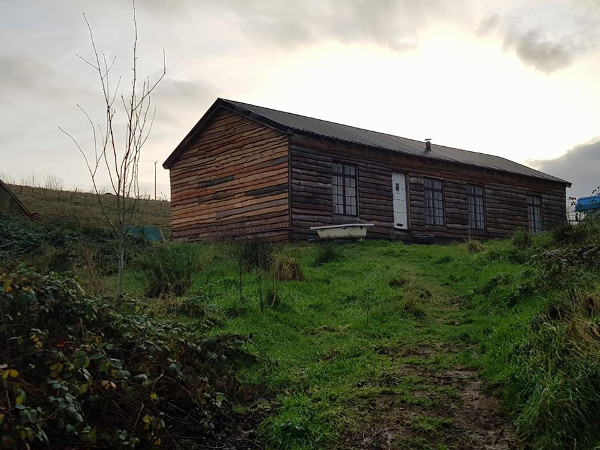
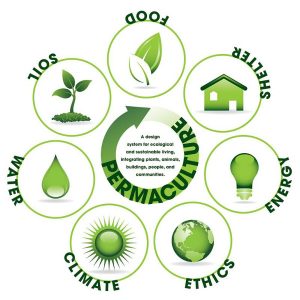
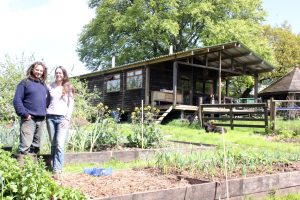


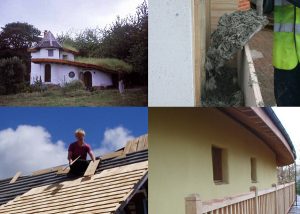
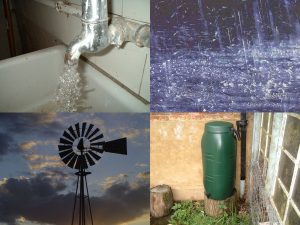
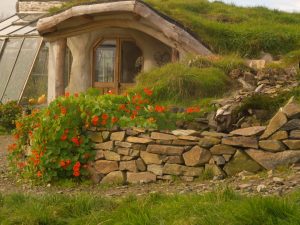

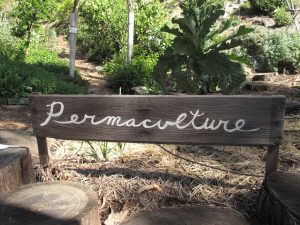
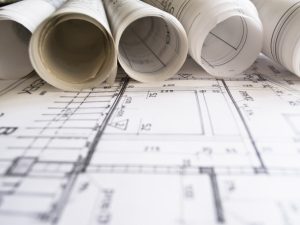
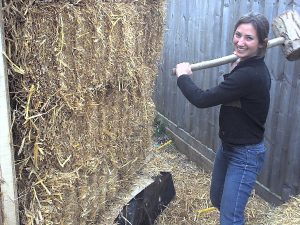
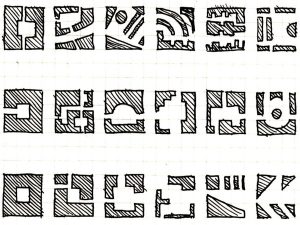
13 Comments
Thanks Paul, so much good stuff there! Have not even read it all yet. I’m researching a history of early permaculture and can say that it was 1974-early 76 that Holmgren and Mollison worked out the shape of Permaculture – when David moved in to Bill’s share house in Hobart.
David – here – https://www.youtube.com/watch?v=THJWRC-1MgA – is talking about late 1974 into 75 in the early part of this video.
Oh, thanks for that. I can’t remember where I got the dates from. Are you planning to publish the results of your research? It sounds interesting.
“This is the transcript of a talk” and another slab of text. As this is a transcript, I wonder of the original recording could have been made available instead/as well?
I know Dave likes reading but I don’t like to read from a computer screen for more than a few minutes. I wonder how many others feel the same?
Thanks for sharing this Paul, loads of good points. I’m beginning to favour the term Capitalocene! Cheers.
I’m not sure whether SBUK were recording talks. Sorry.
Great read. Thanks for sharing.
Ps. Our strawbale house in a dry-hot state in Australia copes well with the extreme heat!
Thanks Paul. This has helped me reappraise how our place works in this scattered community as well as how this old clom house and land fits into a pattern for the future.
Pleased it helped, Llanfach. 🙂
Fantastic article Paul, thank you very much.
Thank you for the mention of beavers 🙂 The beaver is the totem my wife chose for me (unprompted) when we got engaged. I totally agree with your characterisation of them and I intend to spend the rest of my life trying to live up to it.
Well written and touches so many bases. Inspirational and inspring, thank you.
A thought provoking piece – thank you. Is there some petitioning our MP’s/Government/planning depts., with this stuff?; I think some of the more ‘awake’ may be interested in being re-educated. Or is that impossibly naive of me? It has to advance somehow and you chaps seem to be perfectly placed, knowledge and ability-wise, to raise the ‘Low Impact/Permaculture/alternative way of being’ flag in the echelons of power.
Now, THAT would make a banner to rally under!